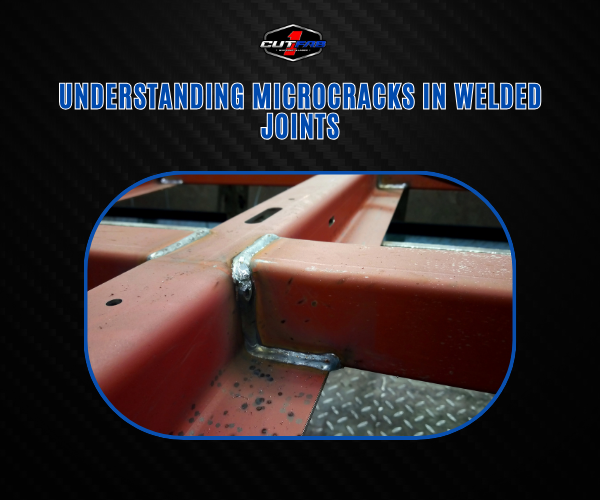
Understanding Microcracks in Welded Joints!
When it comes to welding, strength and durability are everything. But even the most precise welds can be compromised by an invisible enemy—microcracks. These tiny, often undetectable fractures weaken joints from the inside out, leading to reduced load-bearing capacity, premature failures, and costly rework. For industries like aerospace, automotive, and heavy fabrication, a single overlooked microcrack can mean production delays, safety hazards, and significant financial losses. That’s why weld microcracks prevention isn’t just good practice—it’s a necessity. By understanding how microcracks form and how to stop them early, fabricators can ensure stronger, longer-lasting, and more reliable welds.
Causes of Microcracks
Microcracks don’t appear by chance—they form when certain conditions during welding create stress points in the joint. Two of the biggest culprits are thermal stress and contamination, and both are more common than most fabricators realize.
Thermal Stress
Welding is essentially a battle with heat. When molten metal cools, it contracts. If cooling happens too quickly or unevenly, the weld metal and base metal shrink at different rates. This uneven contraction creates residual stress, which can fracture the joint at a microscopic level. High-strength steels, stainless steel, and alloys are especially vulnerable because they have lower tolerance for stress concentration. Think of it like pouring boiling water into a frozen glass—the sudden change in temperature creates cracks, even if the material looked strong beforehand.
Contamination
Even the strongest weld will fail if the materials aren’t clean. Oils, rust, paint, and even small traces of moisture can introduce hydrogen into the weld pool. This leads to hydrogen embrittlement, a key driver of microcrack formation. Contaminants act as weak points, preventing full fusion and leaving voids where cracks can start spreading. Poor shielding gas coverage or dirty filler metals only make the problem worse.
In short, microcracks stem from thermal imbalances and impurities. Without addressing these root causes, any weld repair or inspection becomes a temporary fix rather than a long-term solution. For fabricators aiming at weld microcracks prevention, controlling heat input and maintaining strict material cleanliness are non-negotiable.
Preventive Welding Techniques
If microcracks are the enemy, then prevention is your strongest defense. Instead of waiting until inspection reveals hidden flaws, fabricators should focus on proactive welding techniques that minimize stress and eliminate contamination before cracks even have a chance to form.
Control Heat Input
The first step in weld microcracks prevention is mastering heat control. Preheating the base metal helps reduce temperature gradients, while post-weld heat treatment (PWHT) relieves residual stress. Avoiding excessive amperage or rapid cooling ensures the weld solidifies evenly, reducing the risk of thermal stress fractures.
Proper Joint Preparation
A clean weld starts with clean materials. Before striking an arc, remove rust, oil, paint, or moisture from the surfaces. Using the right filler material and ensuring proper fit-up eliminates voids that could later become crack initiation points.
Shielding Gas and Filler Selection
Choosing the right shielding gas prevents atmospheric contamination, while matching filler metals with the base metal enhances fusion and minimizes brittleness. For critical projects, high-quality consumables make all the difference in weld integrity.
Controlled Welding Sequence
The welding sequence itself matters. Techniques like backstep welding, staggered passes, or balanced welding on both sides of the joint distribute stress evenly, lowering the risk of localized cracking.
In short, preventive welding isn’t just about avoiding mistakes—it’s about building a system of discipline. By controlling heat, preparing materials, selecting proper consumables, and applying the right sequence, fabricators can drastically reduce microcrack risks and ensure stronger, longer-lasting welds.
Case Study: Stainless vs Aluminum Alloys
Not all metals react to welding in the same way. Some are more forgiving, while others demand extra care to avoid microcracks. A closer look at stainless steel and aluminum alloys reveals just how different the challenges can be—and why prevention strategies must be tailored to the material.
Stainless steel is widely used in structural and industrial applications because of its strength and corrosion resistance. However, it’s particularly vulnerable to thermal stress cracking due to its high thermal expansion rate and low heat conductivity. Without preheating or proper heat management, microcracks can easily form at the heat-affected zone.
On the other hand, aluminum alloys bring a different set of challenges. Their high conductivity causes rapid heat dissipation, leading to inconsistent weld pools. Hydrogen contamination is a bigger concern here, often resulting in porosity and microcracks if surfaces aren’t properly cleaned.
Here’s a quick comparison:
|
Factor |
Stainless Steel |
Aluminum Alloys |
|
Main Crack Cause |
Thermal stress from uneven cooling |
Hydrogen contamination & porosity |
|
Heat Conductivity |
Low (retains heat, higher stress risk) |
High (rapid heat loss, inconsistent pool) |
|
Preventive Measures |
Preheating, controlled heat input, PWHT |
Meticulous cleaning, proper shielding gas, slower cooling |
|
Typical Applications |
Construction, piping, heavy machinery |
Automotive, aerospace, lightweight structures |
This case study shows that weld microcracks prevention requires more than one universal solution. Each alloy type demands unique strategies to maintain weld integrity and performance.
Conclusion: Building Durable Welds
Microcracks may be small, but their impact is massive. From hidden weaknesses in structural joints to costly rework in high-precision industries, they represent one of the most persistent threats to weld quality. The good news is that weld microcracks prevention isn’t about guessing—it’s about applying proven methods consistently.
By understanding the causes—whether thermal stress or contamination—fabricators can take control of the welding environment rather than letting defects creep in unnoticed. Preventive techniques like controlled heat input, strict material preparation, and carefully planned welding sequences transform the process from reactive troubleshooting to proactive quality assurance. And as the stainless vs. aluminum case study shows, the best approach depends on the material—reinforcing the need for tailored strategies.
At 1CUTFAB, the focus has always been on delivering precision and reliability. By building discipline into every weld, fabricators don’t just eliminate microcracks—they build stronger, safer, and longer-lasting products that stand the test of time.
